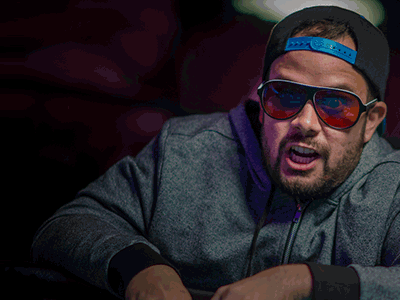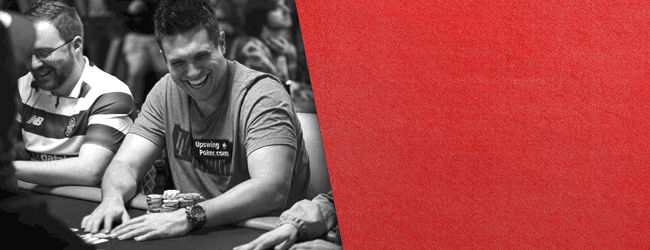3 Tips That Will Skyrocket Your Win-Rate Versus C-Bets Out of Position
Being out-of-position is unfavorable. Being the pre-flop caller is also unfavorable. Put these together and you’ve got a recipe for some tricky post-flop spots.
Not only are we at an informational disadvantage versus an in-position pre-flop raiser, but we are (usually) at a range disadvantage as well. And playing against c-bets in such spots is especially tough given that we are facing a bet from a player with a stronger range.
To make playing out-of-position as the pre-flop caller a little easier, we’ll run through three tips featuring real examples and insights from Doug Polk and Ryan Fee. Let’s get into it.
1. Check-raise with strong value hands and borderline-call bluffs
Check-raising is an essential weapon in the modern poker player’s arsenal. It allows us to extract value with the strongest parts of our range and force folds with our bluffs, thereby mitgating our positional disadvantage.
But it’s especially effective when calling is unappealing, such as when we have draws with no showdown value. Mixing in these bluff check-raises is a very effective strategy–and balances our range–when employed correctly.
It makes sense for us to have a check-raising range on boards where we can have a lot of value; i.e., on textures that give us a range/nut advantage. We should avoid check-raising on boards where we cannot have many strong value hands. Doing so would lead to having a range too heavily weighted towards bluffs, with not enough nutted combos for protection.
(Note: Want to turn your poker hobby into your side job? Start crushing your competition with expert strategies when you join the Upswing Lab. Learn more now!)
Let’s take a look at an example. This hand was submitted by Lab member Toni K.:
$0.50/$1 PokerStars Zoom 6-Handed. 165bb Effective Stacks.
Hero is dealt 9♣ 8♣ in the BB.
UTG folds. MP raises to 3bb. CO folds. BTN folds. SB folds. Hero calls.
Flop (6.5bb): K♠ A♣ 2♣
Hero checks. MP bets 3bb. Hero raises to 9bb. MP raises to 21bb. Hero calls.
Turn (48.5bb): 2♦
Hero checks. MP bets 26bb. Hero folds.
This is an ideal example of when we shouldn’t have a check-raising range as the pre-flop caller, and it demonstrates an important point: having a draw without showdown value (in this case, 9-high) doesn’t mean we should play it aggressively.
For one thing, this board favors our opponent’s range much more than our own, and so we simply don’t have enough value combos to start credibly check-raising here. A closer look at the ranges will illustrate this point.
First, here’s the our opponent’s estimated raise range from middle position:
MP raise range from the Upswing Lab
And here’s what our defend range from the big blind vs a middle position raise:
BB vs MP raise range from the Upswing Lab
The BB caller is at a nut deficit on this board because hands such as AA, KK and AK are in our 3-betting range, so we are not expected to have them when we flat the MP RFI.
Check out the equity comparison for both ranges on this board:
Being a 6% dog here doesn’t tell the whole story, though. The main problem with check-raising here is that we don’t have enough strong value combos on this particular board. Below are two equity matrices that display combos which have 78% or more equity versus the opponent’s range:
(Editor’s note: If you’re confused why AQo, A2s, and 22 adds up to 9 and not 15 combos, so was I! Turns out it’s because only the AQo combos containing the Q♣ have over 78% equity. Math can be fun.)
These matrices show just how disadvantageous the board texture is for the BB caller; we have just 6 nutted combos that have 80% equity or more, namely, 3 combos of 22 and 3 of A2s. By contrast, our opponent has 22 strong combos—more than three times as many (AA, KK, AKs, AKo, A2s, K♣Q♣)!
Check-raising from such a severe range disadvantage is not a smart move. While it might seem a little passive, it’s best to call with our draw in this spot and assess on the turn. The reality is there are some boards where we can’t play our draws aggressively.
2. Don’t be afraid to overbet in polarized spots
Our range becomes polarized when we check-raise, meaning it is comprised of very strong hands and very weak ones (in terms of showdown value) with nothing in between. As such, it makes sense to use a larger bet size that reflects its polarity. This ensures that we get the maximum with our value hands and push as much fold equity as possible with our bluffs.
It’s important to consider effective stack size, and what it will be on later streets. In particular, we want to choose a bet size that allows us to bluff effectively while getting called by worse.
Let’s consider an example. This hand was submitted by Lab member Bobby G. (it has been adjusted slightly):
Online Cash 6-Handed. 106bb Effective Stacks.
Hero is dealt 4♦ 4♣ UTG
Hero raises to 3bb. MP folds. CO raises to 5bb. BTN folds. SB folds. BB calls. Hero calls.
Flop (15.4bb): 5♠ 4♠ T♣
BB checks. Hero checks. CO bets 5.5bb. BB folds. Hero raises to 15.5bb. CO calls.
Turn (46.4bb): 9♣
Hero bets 30bb. CO calls.
River (106.4bb): 6♠
Hero bets 55.5bb and is all-in. CO calls.
Given how wet this board texture is it’s best to play this hand over two streets, intending to get the money in on the turn. If we check-raise 44, 55, 54s (assuming these are in our UTG opening range) and TT at varying frequencies, then we have a total of 12 value combos as raises. Our bluffs on this board, for balance, can include hands like 7♠6♠, 7♣6♣, 8♠7♠, 8♣7♣ and Q♠J♠.
Although the majority of these bluffs have a lot of equity on the flop, none of them are going to win at showdown without improving. By jamming on the turn rather than playing our hand over three streets we generate as much fold equity as possible with our bluffs. And we can still expect to get called by over pairs and the nut flush draw, which is good for us, provided that our range is correctly balanced.
I’d recommend sizing up a little for the flop check-raise in order to make the turn overbet slightly smaller. This spreads the fold equity more evenly across the flop and turn. Raising to around 20bb on the flop and jamming 80bb (into 55bb) on the turn seems about right.
(Note: Looking to greatly increase your poker skills and earnings? Master both fundamental theories and situational exploits when you join the Upswing Lab. Learn more now!)

3. Check-Jamming in Low SPR Situations
When we are out-of-position facing multiple c-bets we’ll often get into situations where our drawing hands aren’t getting the right price to call. This applies particularly on the turn, where calling with our draw can leave little room to bluff on the river because of SPRs or board texture.
In these instances we should consider either jamming or folding the majority of our range, with exceptions for when we want to trap with very strong hands or check-call with nutted draws. Let’s get into these in an example below:
This hand was submitted by Lab member Jordan K.:
PokerStars Zoom 6-Handed. 180bb Effective Stacks.
Hero is dealt Xx Xx in the SB
UTG folds. MP calls. CO folds. BTN folds. Hero raises to 6bb. BB raises to 19bb. MP folds. Hero calls.
Flop (39bb): K♥ Q♦ 8♠
Hero checks. BB bets 24bb. Hero calls.
Turn (87bb): 6♦
Hero checks. BB bets 62bb.
Original poster asks: ‘Do we have any check-raise all-in range here or are we only check-calling?’.
It makes the most sense to predominantly use a raising range here versus this size. Once the pot gets to a size where you cannot profitably call with draws, and the majority of stacks will be in the middle, it’s best to either put it in or fold. If we call on the turn, here, then we will have only about a 1/3 pot-sized bet left on the river—an amount that gives us very little maneuverability. By jamming with our draws as well as our value combos instead, we can at least push some fold equity on the turn.
There are exceptions to this jam/fold range. In particular, we should call with strong hands that heavily block our opponent’s value range. KQ is the obvious example, since it blocks sets and strong pair combos. For balance, we can also call with some of our best draws, such as J♦T♦ or T♦9♦. This allows us to have flushes/straights in our range should they come in on the river.
In general, though, this hand is a spot where we should be all-in or folding with the majority of our range.
That’s a wrap, folks!
Post any questions or suggestions for future articles in the comments below, and good luck at the tables!
Note: Ready to take your poker game to the next level? Crush your competition with strategies from world-class players when you join the Upswing Lab. Learn more now!

Read more from Upswing Poker based on your game of choice:
Cash Games: These 4 Rules Will Help You Choose the Perfect Bet Size
Tournaments: QUIZ – How Much Do You Actually Know About Poker Tournament Strategy?
Live Poker: 5 Skills That Will Boost Your Live Poker Earnings
All Games: Improve Your Results with this 3-Step Poker Warm Up Routine